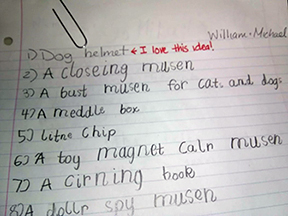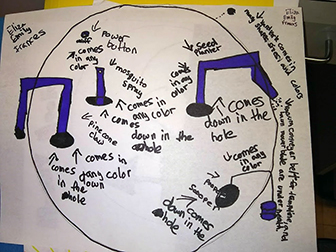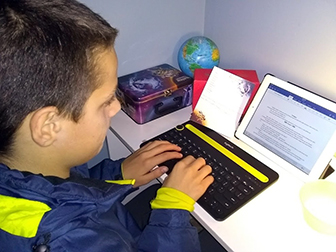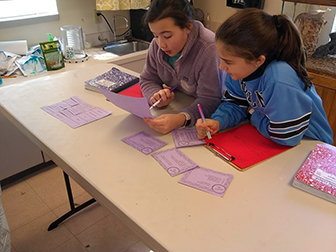Motivating All Types of Learners with ExploraVision
The ExploraVision program may seem like its designed for gifted students, but it’s a competition where learners of all abilities can thrive and succeed. When I first started the program in my classroom, it was daunting to think that I would be asking students who sometimes struggle to write a complete sentence to research and write a whole paper explaining an invention. As with all challenges, the key to success was in scaffolding the learning process and making this daunting project seem manageable and fun. I would like to share how I shift the bulk of the responsibility for the projects onto my students, and the accommodation I provide to enable students of all abilities to succeed in completing an ExploraVision entry.
Letting Students Take the Lead
I teach more than 180 students from preschool through 6th grade. Every child I teach in the 1st through 6th grade completes an ExploraVision entry. Every student. This year we submitted 47 projects and had one regional winner and nine honorable mentions. Last year, we had 42 projects and 14 honorable mentions. Juggling this many projects forces me to take a more hands off approach, since there just isn’t enough of me to go around. The students know that I trust their abilities and they start to feel empowered from the very beginning.
Starting the Brainstorming Process
We start with a whole-class brainstorm of problems that we would like to solve. Once my students have established a broad umbrella of problems to explore, I prompt them to develop possible solutions for each one. After this first brainstorming session, we usually have upwards of 50 potential project ideas to work with. I then take the solutions we generated and do a quick search to see if any of them have already been invented, so that we don’t waste valuable class time researching topics that already exist.

A list of ideas one of my students came up with during the brainstorming process.
The second day of the project, I group my students by their interests to make sure that the ideas they are pursuing are important to them. Within those interest groups, I pair students in groups of two or three or four, based largely on personality and what I’ve learned about their working styles. We hone in on our projects in January, by which point I have a very good idea about which pairings will be most successful. The students spend the day developing their invention or idea and create posters with features of their invention on them. We post them around the room so students can get feedback and advice from their peers. This helps the teams share their idea and start to put it into words, but also gauge the response from others. The kids love being able to talk about their awesome inventions and uncover any problem areas in their ideas.

My students illustrate the features of their invention on a poster.
The brainstorming process is an area in which my students who struggle academically really shine. For them, school can be difficult and frustrating, forcing them to overcome a lot of challenges on a daily basis. This makes them excellent critical thinkers during this portion of the invention competition. Most of my students have amazing ideas and insightful input to improve the ideas of their peers. I can see their confidence and pride swell up as they contribute meaningfully to other projects and their peers consider their ideas.
Guiding the Research Process
Once students present their initial ideas in the first couple days of brainstorming, I make note of topics each group will need to research for their project. The research process can be overwhelming, which is why I provide a handful of resources in the early stages to ensure that all my students can successfully complete this stage regardless of their learning ability.
To get them started, I give each group specific questions to answer along with a handful of search terms. This allows younger students and those who struggle with spelling to succeed independently when looking up information. I also provide a list of reliable, vetted sources for students to use, which prevents them from collecting information from unreliable sources.
To conduct their research, students use iPad Minis and write their answers to the questions in a research document. These devices can read text aloud, which helps students that struggle with reading comprehension to understand the material and contribute meaningfully to their group. The iPads also prevent students from printing off information, which forces them to truly dive into each source to find specific answers for their research questions.

One of my students conducting research on a tablet.
Putting Together the Research Paper and Website
Once the research and development phase of the project is completed, I meet individually with each student to go over the questions provided in the ExploraVision Lesson Plans for their specific project. This helps them identify the weaknesses and strengths of their invention, think more deeply about what needs to happen for the invention to become a reality, and practice describing their invention in great detail. For my students who struggle with dyslexia and other learning differences, I record this meeting on my phone as we talk through their project in detail. I find that these students often speak with a fluency that they struggle to express in writing, so having a transcript of our conversation helps them tremendously when writing their outline.

The peer review process in action.
After each student completes an outline, they go through peer reviews and peer interviews to provide each other with feedback and suggestions for improvement. Students are then able to finalize their projects in the computer room or on a laptop. Again, we have microphones and dictation software for those who need help typing their paper. This is especially helpful for my younger students, who can read their outline aloud for the computer to transcribe. My older students go through more in-depth edits as I provide feedback about grammar, logical transitions, and content. During this review period, students go through a checklist to ensure everything in the paper is correctly formatted and included.
In a fun change of pace from the research paper, students put together project websites as the final step in the ExploraVision process.
Presenting the Final ExploraVision Projects
We celebrate the completion of our ExploraVision projects with a special assembly, where students present their websites to classmates, parents, and the head of the school. Each student is recognized for their participation in ExploraVision with a certificate and prize during this end-of-year ceremony. Students from all ability levels have the chance to shine by sharing their amazing ideas, which are always met with thunderous applause and support from the audience. This is particularly meaningful for some students, especially those who don’t often get the opportunity to win an academic award and take the podium to present their work. Each and every one of them is a true inventor and they deserve to be celebrated for it.
The opportunity to earn prizes and win a trip to Washington D.C. motivates my students to work diligently throughout the entirety of the program. This project elicits some of the best work I receive from my students all year! They are excited to share their ideas, excited by the prizes, and excited that someone outside of our small town might care about something they thought up. They feel heard, they feel smart, and they feel great pride in the final product. This isn’t just something that we should be sharing with advanced students, it is something we should provide for all students!
Download these powerful K-12 science lesson plans to get started!
About the Author
Covey Denton is an educator who believes that students of all learning abilities have the potential to be great critical thinkers and problem solvers. At Greenfield Elementary School, she motivates each and every one of her students to submit a project for the ExploraVision science competition.